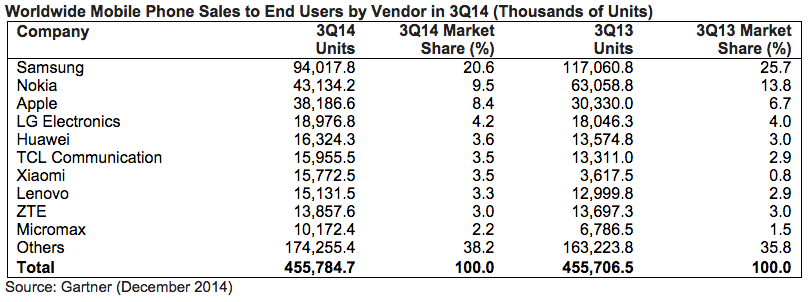Smartphones now account for 66% of all mobile phones worldwide and are on track to see 2014 sales of 1.2 billion units in 2014. But while Android appears to have “won” the so-called platform war, the two-horse race between the leading smartphone vendors — Samsung and Apple — looks like it may finally be breaking up a bit, powered by sales of handsets in emerging markets.
Gartner today published its Q3 numbers for how mobile phones fared globally. A total of 301 million smartphones sold, up 20% on a year ago. Within that, Apple’s and Samsung’s combined smartphone share totalled 37%, down 7 percentage points from the same period a year ago.
Mobile phone sales overall were 456 million — completely flat on Q3 2013.
Within the smartphone space, China’s Xiaomi made its way into the top five for the first time with a sharp rise over a year ago, while the world’s biggest OEM, Samsung, declined.
Apple saw its share increase — up to 38 million, or 12.7% of the market — on strong iPhone 6 sales, a trend other analysts have been tracking as well, while Huawei also saw a small gain to move up to the number-three spot (16 million devices, 5.3%).
That’s not to say that Samsung is not in the lead: it is, by some margin. The Korean handset giant sold 73 million smartphones in Q3, giving it a 24.4% share of the market, although that’s down by almost eight percentage points (and 7 million devices sold) on a year ago. Overall, the company sold 94 million handsets (smart and low-end phones combined) for a 20% share of the market (down five percentage points on a year ago).
Xiaomi’s sales of 16 million smartphones for a 5.2% share of the market is up nearly four percentage points over a year ago (it only sold 3.6 million units in Q3 2013). Gartner says it experienced the highest growth of any vendor this quarter up 336% “driven by strong performance in China where it became market leader.”
Xiaomi’s rise is significant not just because it signals a potential rival to the hegemony of Samsung and Apple, but also because of why it has done so well.
In short, it’s because sales in mature markets (where Samsung traditionally has been strong) are now saturated with smartphones, and so sales have slowed down massively. Emerging markets, on the other hand, are seeing very sharp sales rises — some of the highest ever in smartphone history, in fact.
“From a regional perspective, emerging markets exhibited some of the highest growths ever recorded, with Eastern Europe and the Middle East and Africa achieving the highest increase in the third quarter of 2014, with sales of smartphones growing almost 50% year-over-year,” the analysts write.
This is also another reason why Chinese vendors, who started selling low-cost Android-based handsets to these markets early, are doing so well. In China, one of the most important markets for Samsung, its smartphone sales declined 28.6%.
“With the ability to undercut cost and offer top specs Chinese brands are well positioned to expand in the premium phone market too and address the needs of upgrade users that aspire to premium phones, but cannot afford Apple or Samsung high-end products,” Gartner director Roberta Cozza notes. “The smartphone market is more than ever in flux as more players step up their game in this space.”
As a point of contrast, Western European smartphone sales declined 5.2% — the third consecutive decline this year. Among mature markets, the U.S. saw the highest growth, seeing an 18.9% increase “fostered by the launch of the iPhones 6 and 6 Plus.” But put another way, neither of these two, big mature markets are keeping up with overall sales growth of smartphones, which were up by 20%, or anywhere near the rates of less mature markets.
Gartner predicts that Apple’s momentum will continue unabated with its “biggest ever fourth-quarter sales” of both models of large-screen phones, although there will be other key moves coming from Chinese handset makers.
“Over the holidays we expect record sales of the iPhone 6 and iPhone 6 Plus, but we should not underestimate the Chinese vendors and local brands,” writes Annette Zimmermann, research director at Gartner. “Chinese players will continue to look at expanding in overseas emerging markets. In Europe prepaid country markets and attractive lost-cost LTE phones will also offer key opportunities for these brands.”

While OEM movement is definitely apace right now, the situation is very different for platforms. The platform “war”, it seems, has essentially now been won by Android. Its share is now at 83.1% on sales of 250 million units. Apple trails well behind in second place, while Windows, BlackBerry and “Other OS”‘s all continue their declines.
In real terms, Windows sales were nearly flat over a year ago on 9 million units. It’s very hard to think of how Microsoft will manage to turn this around, and you do have to wonder if the company will eventually give up the ghost.
Gartner, perhaps trying to find some silver lining, notes that at least the Q3 number was up on Q2. “Microsoft needs to keep the momentum going from the third quarter, when Windows phone-based devices grew quarter-on-quarter thanks to the introduction of more mid-range devices,” writes Zimmermann.

The big picture for feature phones is not unlike that of Microsoft legacy smartphone maker BlackBerry: it’s a trend of decline. Feature phone sales are down by 25% over a year ago.
Interestingly, Gartner doesn’t peg this drop to the ineluctable charm of smartphones, but rather says it’s because of the narrowing price difference between them and basic devices. Smartphones are already 66% of the world’s total mobile market and by 2018 Gartner predicts that proportion will be 90%.

